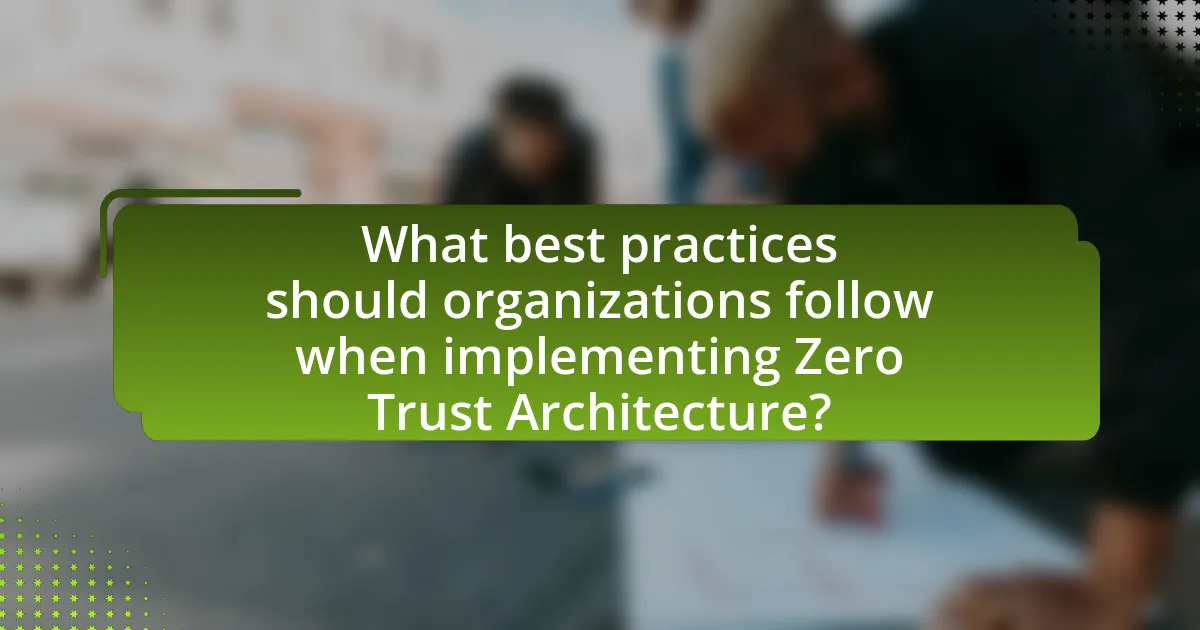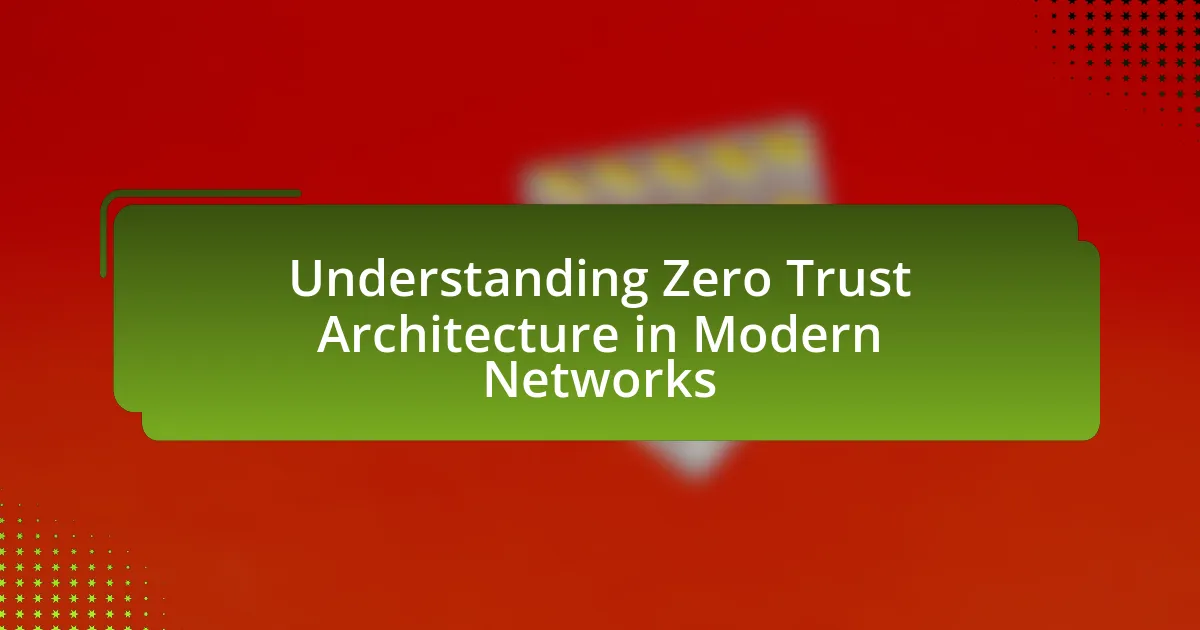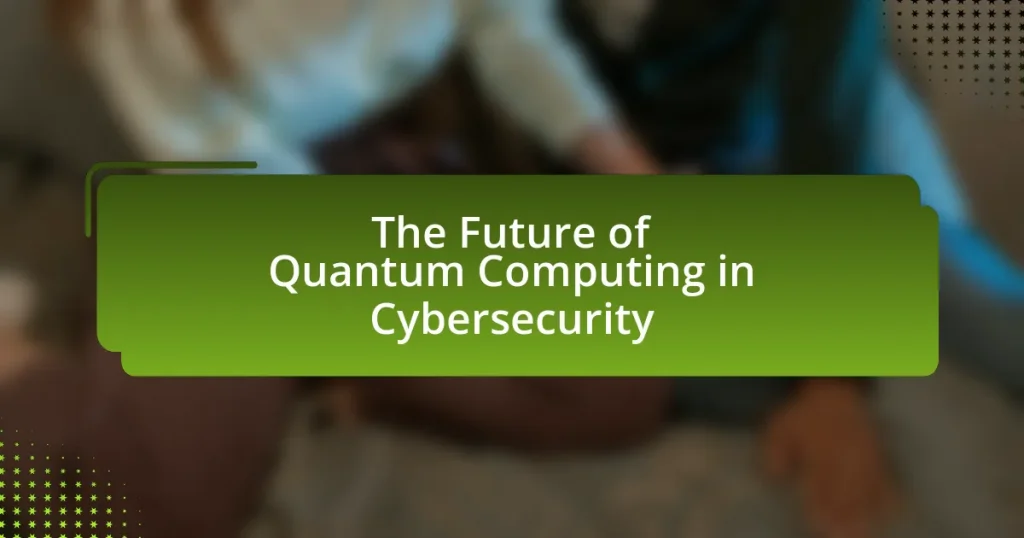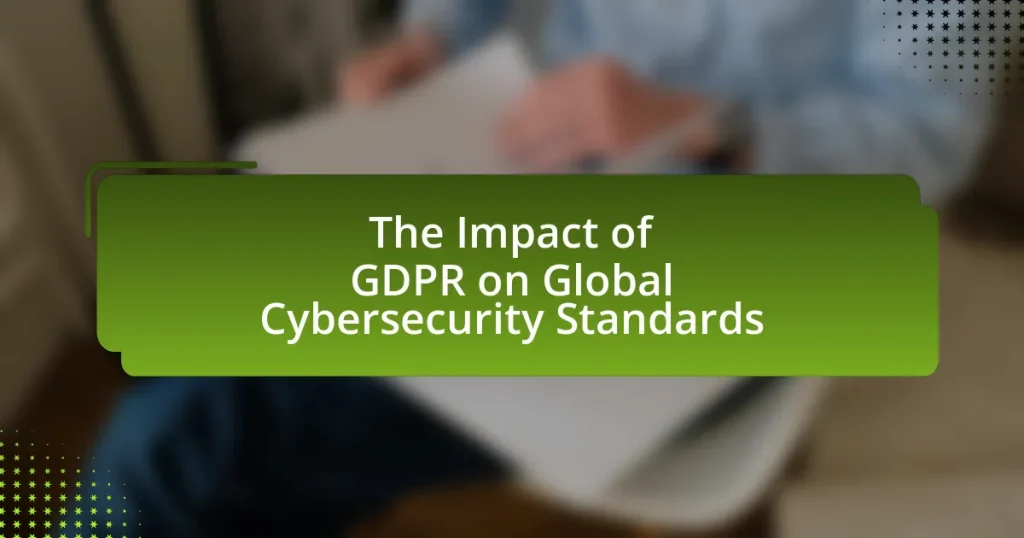Zero Trust Architecture (ZTA) is a cybersecurity model that mandates strict identity verification for all users and devices accessing network resources, regardless of their location. This approach, based on the principle of “never trust, always verify,” significantly reduces the risk of data breaches and insider threats by continuously monitoring user behavior and enforcing least privilege access. The article outlines the key principles and core components of ZTA, discusses its advantages over traditional security models, and highlights the technologies that support its implementation. Additionally, it addresses the challenges organizations face when adopting Zero Trust, best practices for successful implementation, and the importance of continuous monitoring and user training in maintaining a robust security posture.

What is Zero Trust Architecture?
Zero Trust Architecture is a cybersecurity model that requires strict identity verification for every person and device attempting to access resources on a network, regardless of whether they are inside or outside the network perimeter. This approach is based on the principle that threats can originate from both external and internal sources, necessitating continuous verification and least-privilege access. According to a 2021 report by Forrester Research, organizations implementing Zero Trust can reduce the risk of data breaches by up to 80%, highlighting its effectiveness in modern network security.
How does Zero Trust Architecture differ from traditional security models?
Zero Trust Architecture (ZTA) fundamentally differs from traditional security models by adopting a “never trust, always verify” approach, which assumes that threats can exist both inside and outside the network perimeter. Traditional security models typically rely on a strong perimeter defense, trusting users and devices within the network once they are authenticated. In contrast, ZTA continuously verifies user identities and device security postures, regardless of their location, thereby minimizing the risk of insider threats and lateral movement within the network. This shift is supported by the increasing complexity of cyber threats and the rise of remote work, necessitating a more robust security framework that protects sensitive data and resources effectively.
What are the key principles of Zero Trust Architecture?
The key principles of Zero Trust Architecture include the following: verifying every user and device, enforcing least privilege access, and continuously monitoring and validating trust. Verifying every user and device ensures that no one is trusted by default, regardless of their location within or outside the network. Enforcing least privilege access limits user permissions to only what is necessary for their role, reducing potential attack surfaces. Continuously monitoring and validating trust involves real-time assessment of user behavior and device health to detect anomalies and respond to threats promptly. These principles are essential for enhancing security in modern networks, as they address the evolving landscape of cyber threats and the need for robust defense mechanisms.
Why is the concept of “never trust, always verify” crucial?
The concept of “never trust, always verify” is crucial because it establishes a security framework that assumes threats can exist both outside and inside a network. This principle is essential in modern cybersecurity, where traditional perimeter defenses are often insufficient due to sophisticated attacks and insider threats. By implementing this approach, organizations can minimize the risk of data breaches and unauthorized access, as it requires continuous verification of user identities and device integrity before granting access to resources. This methodology is supported by the increasing number of data breaches; for instance, the 2021 Verizon Data Breach Investigations Report indicated that 85% of breaches involved a human element, highlighting the need for stringent verification processes.
What are the core components of Zero Trust Architecture?
The core components of Zero Trust Architecture include identity verification, least privilege access, micro-segmentation, continuous monitoring, and data encryption. Identity verification ensures that every user and device is authenticated before accessing resources, minimizing the risk of unauthorized access. Least privilege access restricts user permissions to only what is necessary for their role, reducing potential attack surfaces. Micro-segmentation divides the network into smaller, isolated segments, limiting lateral movement within the network. Continuous monitoring involves real-time analysis of user behavior and network traffic to detect anomalies and respond to threats promptly. Data encryption protects sensitive information both in transit and at rest, ensuring confidentiality and integrity. These components collectively reinforce a security posture that assumes breaches can occur and mitigates risks accordingly.
How do identity and access management play a role in Zero Trust?
Identity and access management (IAM) is crucial in Zero Trust architecture as it ensures that only authenticated and authorized users can access resources. In a Zero Trust model, IAM enforces strict identity verification for every user, device, and application attempting to access network resources, regardless of their location. This approach minimizes the risk of unauthorized access and data breaches by continuously validating user identities and their access rights. According to a 2021 Forrester report, organizations implementing IAM within a Zero Trust framework experienced a 50% reduction in security incidents, highlighting the effectiveness of IAM in enhancing security posture.
What technologies support the implementation of Zero Trust?
Technologies that support the implementation of Zero Trust include identity and access management (IAM), multi-factor authentication (MFA), micro-segmentation, endpoint security, and security information and event management (SIEM). IAM solutions enable organizations to enforce strict access controls based on user identity, while MFA adds an additional layer of security by requiring multiple forms of verification. Micro-segmentation allows for the isolation of network segments to limit lateral movement within the network, enhancing security. Endpoint security solutions protect devices from threats, ensuring that only secure endpoints can access resources. SIEM systems provide real-time analysis of security alerts generated by applications and network hardware, facilitating rapid response to potential threats. These technologies collectively create a robust framework for implementing Zero Trust principles, ensuring that trust is never assumed and access is continuously verified.
What challenges are associated with implementing Zero Trust Architecture?
Implementing Zero Trust Architecture presents several challenges, including complexity in deployment, integration with existing systems, and cultural resistance within organizations. The complexity arises from the need to redefine security policies and access controls for every user and device, which can be resource-intensive and time-consuming. Integration challenges occur as organizations must ensure that legacy systems and applications can work within a Zero Trust framework, often requiring significant modifications or replacements. Additionally, cultural resistance can hinder adoption, as employees may be accustomed to traditional security models and may view the increased scrutiny as a barrier to productivity. These challenges are supported by industry reports indicating that 70% of organizations cite integration with existing infrastructure as a major hurdle in adopting Zero Trust principles.
How can organizations overcome resistance to adopting Zero Trust?
Organizations can overcome resistance to adopting Zero Trust by implementing comprehensive education and training programs that highlight the benefits and necessity of this security model. By providing clear communication about how Zero Trust enhances security and mitigates risks, organizations can address misconceptions and fears among employees. Research indicates that organizations that invest in training see a 70% increase in employee buy-in for new security initiatives. Additionally, involving stakeholders in the planning and implementation process fosters a sense of ownership and reduces resistance. Engaging employees through pilot programs can also demonstrate the effectiveness of Zero Trust in real-world scenarios, further easing concerns and promoting acceptance.
What are the potential costs involved in transitioning to Zero Trust?
The potential costs involved in transitioning to Zero Trust include technology investments, personnel training, and ongoing maintenance expenses. Organizations typically face initial costs for acquiring new security tools and technologies, such as identity and access management systems, network segmentation solutions, and continuous monitoring tools. According to a report by Forrester Research, companies can expect to spend between $1 million to $5 million on Zero Trust implementation, depending on the size and complexity of their existing infrastructure. Additionally, training staff to adapt to new protocols and security measures incurs further costs, as employees must be educated on Zero Trust principles and practices. Ongoing maintenance and updates to the Zero Trust architecture also contribute to long-term financial commitments, as organizations must continuously assess and enhance their security posture to address evolving threats.

How does Zero Trust Architecture enhance security in modern networks?
Zero Trust Architecture enhances security in modern networks by enforcing strict access controls and continuous verification of user identities and devices. This model operates on the principle of “never trust, always verify,” meaning that no user or device is trusted by default, regardless of whether they are inside or outside the network perimeter. By implementing micro-segmentation, organizations can limit lateral movement within the network, reducing the risk of unauthorized access to sensitive data. Additionally, Zero Trust utilizes real-time monitoring and analytics to detect anomalies and respond to threats promptly, thereby strengthening the overall security posture. According to a 2021 report by Forrester Research, organizations that adopted Zero Trust principles experienced a 50% reduction in security breaches, demonstrating its effectiveness in enhancing network security.
What specific threats does Zero Trust Architecture address?
Zero Trust Architecture addresses specific threats such as insider threats, data breaches, and advanced persistent threats (APTs). By implementing strict access controls and continuous verification of user identities, Zero Trust mitigates the risk of unauthorized access from both external and internal sources. According to a 2021 report by Cybersecurity Insiders, 70% of organizations reported that Zero Trust significantly reduced their risk of data breaches, highlighting its effectiveness in combating these threats.
How does Zero Trust mitigate insider threats?
Zero Trust mitigates insider threats by enforcing strict access controls and continuous verification of user identities, regardless of their location within the network. This approach limits the potential for unauthorized access by requiring users to authenticate themselves for every access request, thereby reducing the risk of malicious actions from insiders. According to a report by Forrester Research, organizations implementing Zero Trust can reduce the risk of insider threats by up to 50% due to its emphasis on least privilege access and real-time monitoring of user activities.
What role does data encryption play in Zero Trust security?
Data encryption is a critical component of Zero Trust security, as it ensures that sensitive information remains protected regardless of its location. In a Zero Trust model, where trust is never assumed and verification is required for every access request, encryption safeguards data both at rest and in transit, mitigating the risk of unauthorized access and data breaches. For instance, according to the 2021 Verizon Data Breach Investigations Report, 61% of data breaches involved the use of stolen credentials, highlighting the importance of encryption in protecting data even when access controls fail. Thus, data encryption not only enhances the security posture of a Zero Trust architecture but also aligns with its fundamental principle of “never trust, always verify.”
How does Zero Trust Architecture support remote work environments?
Zero Trust Architecture supports remote work environments by enforcing strict access controls and continuous verification of user identities, regardless of their location. This model assumes that threats can exist both inside and outside the network, requiring all users to authenticate and authorize their access to resources. For instance, according to a 2021 report by Forrester Research, organizations implementing Zero Trust saw a 50% reduction in security breaches, demonstrating its effectiveness in protecting remote work setups. By segmenting access based on user roles and employing multi-factor authentication, Zero Trust ensures that only authorized personnel can access sensitive data, thereby enhancing security in remote work scenarios.
What are the implications of Zero Trust for remote access solutions?
Zero Trust significantly enhances remote access solutions by enforcing strict identity verification and continuous monitoring of user activity. This approach ensures that every access request, regardless of the user’s location, is authenticated and authorized based on predefined security policies. For instance, according to a 2021 report by Forrester Research, organizations implementing Zero Trust architecture experienced a 50% reduction in security breaches related to remote access. This model minimizes the risk of unauthorized access and lateral movement within networks, thereby strengthening overall security posture.
How can Zero Trust improve security for cloud services?
Zero Trust improves security for cloud services by enforcing strict access controls and continuous verification of users and devices. This model operates on the principle of “never trust, always verify,” meaning that every access request is authenticated and authorized regardless of its origin. For instance, according to a 2021 report by Cybersecurity Insiders, organizations implementing Zero Trust architecture experienced a 50% reduction in security breaches. By segmenting access and minimizing the attack surface, Zero Trust effectively mitigates risks associated with unauthorized access and data breaches in cloud environments.

What best practices should organizations follow when implementing Zero Trust Architecture?
Organizations should follow several best practices when implementing Zero Trust Architecture, including continuous verification of user identities, strict access controls, and micro-segmentation of networks. Continuous verification ensures that every access request is authenticated and authorized, reducing the risk of unauthorized access. Strict access controls limit user permissions based on the principle of least privilege, ensuring users only have access to the resources necessary for their roles. Micro-segmentation further enhances security by dividing the network into smaller, isolated segments, making it harder for attackers to move laterally within the network. These practices collectively strengthen the security posture of organizations by minimizing potential attack surfaces and ensuring that security measures are consistently applied across the network.
How can organizations assess their readiness for Zero Trust?
Organizations can assess their readiness for Zero Trust by conducting a comprehensive security assessment that evaluates their current security posture, policies, and technologies. This assessment should include identifying critical assets, understanding user access patterns, and evaluating existing security controls against Zero Trust principles, such as least privilege access and continuous monitoring.
To validate this approach, a study by Forrester Research indicates that organizations implementing a Zero Trust framework experience a 50% reduction in security breaches, highlighting the importance of a thorough readiness assessment in achieving effective security outcomes.
What steps should be taken to develop a Zero Trust strategy?
To develop a Zero Trust strategy, organizations should implement the following steps: first, identify and classify all assets, including data, applications, and devices. This foundational step ensures that the organization understands what needs protection. Next, establish strict identity and access management protocols, ensuring that only authenticated and authorized users can access resources. This can be achieved through multi-factor authentication and role-based access controls.
Following this, organizations should continuously monitor and log all network activity to detect anomalies and potential threats in real-time. This monitoring is crucial for maintaining security and responding to incidents swiftly. Additionally, organizations must segment their networks to limit lateral movement by potential attackers, thereby containing breaches and minimizing damage.
Finally, organizations should regularly review and update their security policies and technologies to adapt to evolving threats and ensure compliance with industry standards. This iterative process is essential for maintaining an effective Zero Trust posture. Each of these steps is supported by industry best practices and frameworks, such as the NIST Cybersecurity Framework, which emphasizes the importance of continuous assessment and improvement in security strategies.
How can continuous monitoring enhance Zero Trust effectiveness?
Continuous monitoring enhances Zero Trust effectiveness by providing real-time visibility into user behavior and network activity, allowing for immediate detection of anomalies. This proactive approach enables organizations to identify potential threats and respond swiftly, thereby minimizing the risk of data breaches. According to a study by Forrester Research, organizations implementing continuous monitoring within a Zero Trust framework can reduce the average time to detect a breach from 206 days to just 21 days, significantly improving their security posture.
What are common pitfalls to avoid in Zero Trust implementation?
Common pitfalls to avoid in Zero Trust implementation include inadequate identity verification, neglecting to segment networks, and failing to continuously monitor and adapt security policies. Inadequate identity verification can lead to unauthorized access, as users may not be properly authenticated before gaining access to sensitive resources. Neglecting network segmentation can create vulnerabilities, allowing attackers to move laterally within the network once they gain access. Additionally, failing to continuously monitor and adapt security policies can result in outdated defenses that do not respond to evolving threats. These pitfalls can undermine the effectiveness of a Zero Trust architecture, making it crucial for organizations to address them proactively.
How can organizations ensure proper user training and awareness?
Organizations can ensure proper user training and awareness by implementing structured training programs that focus on the principles of Zero Trust Architecture. These programs should include regular workshops, online courses, and hands-on simulations that educate users about security protocols, potential threats, and their roles in maintaining security. Research indicates that organizations with comprehensive training programs experience a 70% reduction in security incidents, highlighting the effectiveness of ongoing education in fostering a security-conscious culture. Additionally, organizations should utilize metrics to assess training effectiveness and adapt content based on user feedback and evolving threats, ensuring that training remains relevant and impactful.
What role does regular auditing play in maintaining Zero Trust?
Regular auditing is essential in maintaining Zero Trust by continuously verifying user identities and access permissions. This process ensures that only authorized users have access to sensitive resources, thereby minimizing the risk of data breaches. Regular audits help identify and rectify any discrepancies in access controls, ensuring compliance with security policies. According to a study by Forrester Research, organizations that implement regular auditing as part of their Zero Trust strategy experience a 50% reduction in security incidents. This demonstrates that consistent auditing not only reinforces security measures but also enhances the overall integrity of the Zero Trust framework.
What practical tips can organizations use to successfully adopt Zero Trust Architecture?
Organizations can successfully adopt Zero Trust Architecture by implementing a few key strategies. First, they should conduct a thorough assessment of their current security posture to identify vulnerabilities and critical assets. This assessment enables organizations to understand where to focus their Zero Trust efforts.
Next, organizations must segment their networks to limit access to sensitive data and resources, ensuring that users only have access to what is necessary for their roles. This principle of least privilege is fundamental to Zero Trust.
Additionally, organizations should implement strong identity and access management (IAM) solutions, including multi-factor authentication (MFA), to verify user identities before granting access. This step significantly reduces the risk of unauthorized access.
Regular monitoring and logging of user activity are also essential, as they provide insights into potential security incidents and help organizations respond quickly to threats.
Finally, continuous education and training for employees about security best practices and the importance of Zero Trust principles can foster a security-conscious culture within the organization.
These practical tips are supported by industry reports, such as the 2021 Zero Trust Adoption Report by Cybersecurity Insiders, which highlights the importance of network segmentation and IAM in successful Zero Trust implementations.



